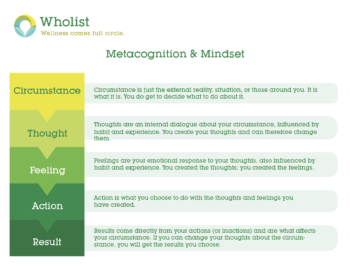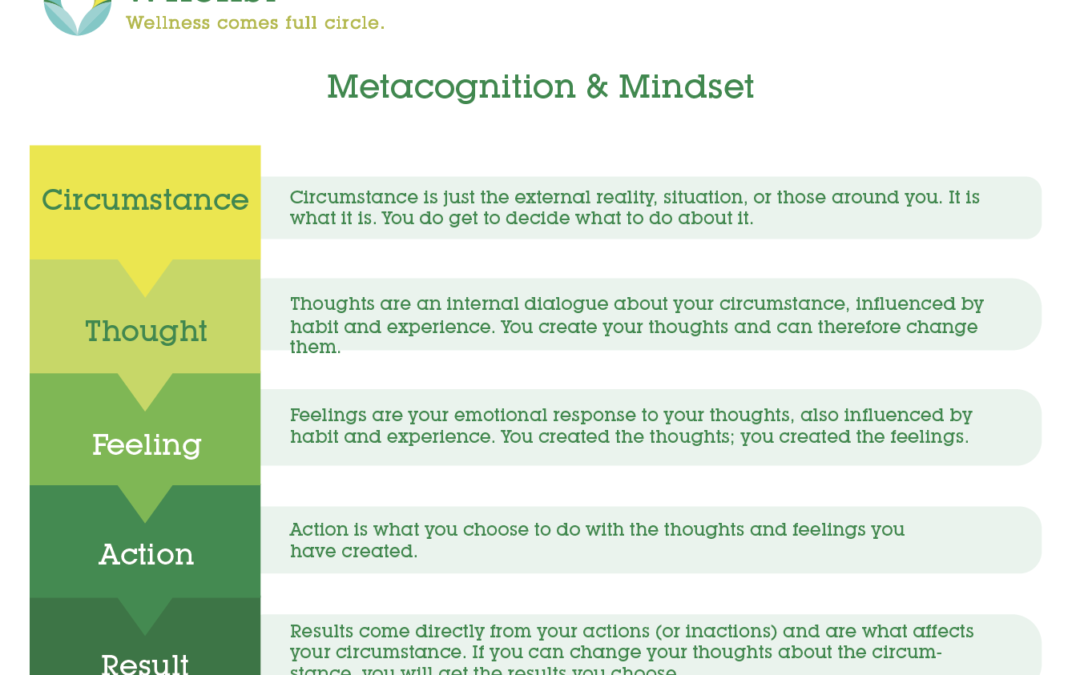Last week we talked about the idea of setting new thought train tracks for ourselves, instead of allowing our brains to make thought “autocorrects”. Today we are really going to dig in. Now remember, I’m a wholist type of physician, meaning I strongly believe we won’t get the whole body health we deserve without concentrating on the mind. I’m also a total geek, so what you are getting below is a combo of me- culminating in on of my many lifestyle physician weight coach strategies. But it can be so much more than just that. So let’s do it.
Metacognition is “cognition about cognition”, “thinking about thinking”, “knowing about knowing”, becoming “aware of one’s awareness” and higher-order thinking skills. The term comes from the root word meta, meaning “beyond”. Metacognition can take many forms. It includes knowledge about when and how to use particular strategies for learning or for problem solving. More precisely, it refers to the processes used to plan, monitor and assess one’s understanding and performance.
Metacognition includes a critical awareness of: A) One’s thinking and learning, and B) Oneself as a thinker and learner.
What are you talking about, Hammer?? Insert wide eye emoji here. Hang in there.
CIRCUMSTANCE -> THOUGHT, FEELING, ACTION, RESULT.
 Download it here…Metacognition & Mindset – Lifestyle Transformation
Download it here…Metacognition & Mindset – Lifestyle Transformation
Let’s work through this CIRCUMSTANCE -> THOUGHT, FEELING, ACTION, RESULT.
Flow first from the beginning forward…. then talk about how to work it from the end, which may be even more helpful. I am no neuroscientist, so bear with my simplicity, and I’m not a life coach, but I do borrow from both here to explain this in a way that makes sense to me. How to rewrite our thoughts for different results using our own cognitive behavioral therapy.
CIRCUMSTANCE: This is something that is happening in you or around you. There is beeping in your office. Your work colleague is cranky. It is below freezing outside. Your kids are hyper and frustrated. You stubbed your toe and it is hurting. You do not have control over the circumstance – I.e. what is happening around you (or in your body) – but you do have control over what happens next.
THOUGHT: Your thought pops up and tells you how it wants you to interpret the circumstance around you based on prior experiences, prior emotions and how your body and brain are currently physiologically. You think you don’t have control over your thoughts but you TOTALLY DO; more on this later. Let’s choose the circumstance of the cranky work colleague. You notice that he is cranky and you notice a thought “God. Today is going to be awful. He is acting like that” or “Why is he acting like that to ME?” or you could notice a thought, “Geez. He must be going through some stuff” or, “What do we need to do to fix the emotions around here?” You can retrain yourself to alter the context of the interpretation of the circumstance and choose new thoughts. You can be an observer of your own thoughts and change them to get the feelings, actions and results that you want.
FEELING: I like to think of feelings and sensations as two related sides of a coin. Your sensations are messages your body is sending to your brain (hot, cold, pain, pulse, hunger) to tell it what is going on in the body and around the body. Your feelings (emotions) are messages your brain is sending down to the body to tell it how to react to things. Feelings, also then, are coming from thoughts you have. Your brain notices sensations/circumstance, has a thought based on the context and sends emotions/feelings back to the body to react. So, your feelings are under your control because your THOUGHTS are under your control.
ACTION; Action is a physical reaction to the circumstance, thought and feeling. In the current example, an action would be either to notice that the work colleague is cranky, think that he is mad about something about you and think that today is going to be terrible, feel apprehensive, guarded and angry to protect yourself and then act by ignoring him in meetings, refusing to answer his email or by yelling at him. OR you could notice the work colleague is cranky, think that he must be frustrated or sad by something or maybe hungry or hungover, and feel empathy and act by asking if you can help alleviate some stress perhaps by bringing him some coffee or take a phone call for him while he takes a break. If you automatically THINK that he is angry at you, stop, notice and then reframe your thought into something more positive or mindful.
RESULT: This is the reaction to your action. Your act of being outwardly disruptive to him made everyone be less productive. Your act of being a helpful coworker caused your colleague to be able to take a break and be more productive for the day.
CIRCUMSTANCE -> THOUGHT, FEELING, ACTION, RESULT
In terms of food choices for example, your circumstance might be that you are busy at work and didn’t get a lunch break as expected. Your thought is that you work too hard and deserve to eat whatever you want. Your feeling is frustration and constraint. Your action is to eat the pizza that someone brought as a “thank you” or cake that someone had for a birthday. Your result is that you altered your food plan, ate food you know you didn’t want to and gained weight this week. Your new circumstance is weight gain.
Your new thought is you are failing your diet, and you are terrible and going to be fat forever or that the “diet” isn’t working. Your new feeling is shame, anger and mistrust. Your new action is to quit the food plan by eating to feel better about your emotions. Your new result is that you are still gaining weight.
What if your choice had been to notice the thought, “I work too hard and deserve to eat whatever I want”, and say, “No. I’m going to change that. I don’t think like that anymore” and make a new thought, “I worked so hard today and got so much done because I’ve been fueling my body with the nutrients it needs to keep my brain and body happy, and I feel great about that, so I’m going to go do that again!” Track that down through feelings (proud, satisfied, happy), action (eating a preplanned and prepacked whole food meal), and result (feeling good, sleeping better, more productive, less shame, less weight).
Get it? It seems like a false paradigm, like you are tricking yourself but you really are not. You are choosing your thought to get the result you want.
Now let’s try to go backwards. The result is you want to lose weight and feel better and more well. The action is that you have to preplan your meals and choose to follow your plan regardless of the situation. The feeling is that you have to WANT to CHOOSE to follow your plan. The thought is that you are noticing your circumstance, but the context is now that you KNOW what results you want, and you WANT to choose to get that results, so you change your thought consciously to do so.
SO you see how this is applicable to ALL parts of life? You see how it is helping you create thought train tracks to follow, instead of letting your brain make autocorrect mistakes and leading you down the wrong path? Play with this as much as you can. Soon it will be second nature with parenthood, relationships, work, food, etc.
Enjoy and you are welcome. This has changed my life.
Who I am
I am Dr Heather Hammerstedt, I am a physician with my doctorate in medicine, board certifications in emergency medicine and lifestyle medicine, an integrative nutrition health coaching certificate, a medical acupuncture certificate, a masters in public health, and two tiny crazy muppet humans and a hilarious husband who keep me honest. I’m also the CEO and Founder of Wholist, a lifestyle medicine coaching and consulting company that specializes in helping busy professional women transform their current and future health futures to meet their goals, all with evidence, education, empowerment delivered by flexible technology to meet you where you are to help you succeed.
And if you loved this? Come meet me for a free life changing weight wellness strategy call – book TODAY here




